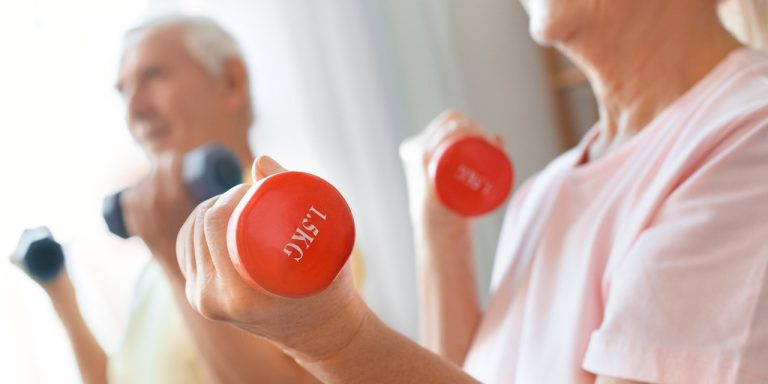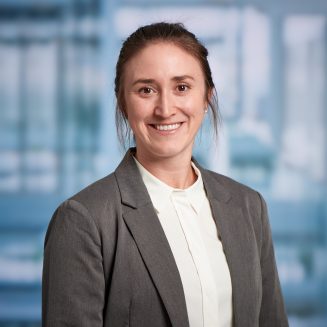
Building muscle in old age: nutrition and exercises
How do you build muscle in old age and how long does it take? What are the best exercises for strength training in old age? Whether you want to build muscle at 50 or later, here are some standing and seated exercises, with and without dumbbells.
Why is building muscle important in old age?
A lot of things get harder as we age. Our strength diminishes, climbing stairs is more of an effort, we become less steady on our feet. This is because muscle mass reduces as you age. Where functionality is severely restricted by this, experts refer to this as sarcopenia (or, colloquially, muscle wastage in old age).
The risk of elevated muscle wastage in old age may be increased by restricted movement or a lack of variation in the diet. A deficiency of hormones like testosterone or oestrogen may also trigger this. The same goes for a significant vitamin D deficiency.
People with sarcopenia fall more often and are at greater risk of injury. This makes maintaining muscle mass and promoting muscle development in old age all the more important.
Symptoms of muscle wastage in old age
Loss of muscle in old age doesn’t cause any issues initially, but left to progress, the following symptoms may occur:
- Those affected become unsteady while walking. They move slowly and occasionally trip.
- They fall more often.
- They also have less physical strength. This makes it more difficult for them to cope with everyday tasks. This becomes apparent, for instance, when climbing the stairs or when getting out of bed after lying down for an extended period of time. Those affected need to take breaks more frequently and are less active on the whole.
These symptoms cause those affected to sustain injuries more often, e.g. femoral neck fractures or even head injuries. In many cases they are afraid of further falls in old age. This makes them increasingly dependent on support.
How much muscle do you lose in old age?
People generally lose 30 to 50% of their muscle mass by the age of 80. The reason for this is that the body converts muscle into fatty tissue as it ages. When does muscle start to degrade? Muscle mass starts to reduce as early as 30, with the proportion of muscle falling by roughly 0.3 to 1.3% each year.
Muscle wastage in old age – what can you do about it?
Strength training in old age can help you strengthen your muscles and make your everyday routine more active. But how long does it take to build muscle, how important is diet in this, and what are the best exercises? The following sections provide answers to these questions.
Building muscle in old age through diet
Diet plays an important role when it comes to building muscle in old age. Ideally this should be a balanced diet rich in the following nutrients:
- Protein: researchers have discovered that our protein needs increase by around 20% from the age of 60. Ideally you should consume 1 to 1.2 grams of protein per kilogram of body weight daily at this stage. For example, the ideal protein intake for a body weight of 70 kilograms is between 70 and 84 grams. Foods that contain protein include fish, meat and eggs, for example. Pulses, dairy and soya products contain protein, too.
- Unsaturated fatty acids: likewise, unsaturated fats are key to building muscle in advanced age too. So opt for extra virgin olive oil, cold pressed rapeseed, walnut or linseed oil, avocados, olives, seeds and nuts. Certain varieties of fish, like salmon or mackerel, contain unsaturated fatty acids too.
Cover your daily energy needs by enjoying a balanced diet. The Swiss Society for Nutrition’s food pyramid serves as a good guide.
Important: diet cannot help you build muscle faster in old age; it can only support it. The aforementioned nutrients alone are not sufficient to build muscle. Physical activity is essential above all (e.g. strength training).
A balanced and protein-rich diet alone is not enough to build muscle. Strength training from the ages of 50, 60 or 70 onwards is just as important. Used in conjunction, both enable effective muscle development in old age.
Building muscle in old age: exercises
There are specific strength training exercises for building muscle in old age. The following exercises are done without any equipment:
- Squats: slowly lower your buttocks backwards. Bend your knees with your back straight. Then bring your buttocks back up and return to the starting position. If you can, repeat this strength training exercise with two sets of 15 squats each. Need a simpler version of this exercise? Then hold on to the back of a chair.
- All-fours position: this exercise is suitable for strength training at home too. Kneel on the floor. Place your hands on the floor below your shoulders. Ensure your back stays straight and parallel to the floor. Keep your hands on the floor and stretch each leg back and upwards, alternating between them. This helps to build muscle in the legs. Or – to be more precise – it helps older individuals to train their buttock muscles. You can also add in arms if you want to intensify the exercise. Stretch your right leg back and your left arm forward at the same time, then swap sides. This also helps to activate the core muscles. Perform this exercise in two sets of 10 to 15 repetitions each.
- Push-ups: support yourself by placing your hands on a table. Lower your upper body towards the tabletop, elbows bent, legs stretched. Slowly lift your upper body back up. Do this exercise as often as you like.
- Mountain climbing: the mountain climbing exercise is ideal for training the torso, hip flexors and arms. Support yourself by placing your hands on a tabletop. Extend your arms. Now lift your knees up alternately. Want to make the exercise more difficult? Get into the push-up position on the floor and pull each of your knees in towards your chest alternately.
Older individuals can also support muscle building with these seated exercises:
- Hip raises: position yourself on the edge of a chair. Keep your feet slightly apart and form a right angle with your knees. Clasp your hands. Lean forward slightly and press your heels to the floor. Now briefly lift your buttocks a few centimetres. Then lower them again.
- Torso tense: get into the same starting position as for the hip raise exercise. Move your pelvis slightly forward and draw your belly button in. Tense your buttocks and push your shoulders back with your back straight until your feet lift off the floor slightly. Do not touch the back of the chair and lower your chin slightly. Hold this position for a few seconds, then straighten out your body and relax before reclining again.
- Arm raises: sit on a chair. Form a right angle with your calves and thighs. Clench your right hand into a fist. Lift your right arm straight up, to the side and then forward. Repeat the exercise 10 to 15 times, then swap sides.
In addition to zero-equipment exercises, there are also some with dumbbells. Use dumbbells weighing from 500 grams to 2 kilograms. Depending on your physique, you can also use heavier dumbbells. It is important that you can perform the movements cleanly. These exercises help to build muscle from age 50 or older, too:
- Shoulder training: for this strength training exercise, you should stand upright with your feet shoulder-width apart. Keep your elbows and upper arms by the sides of your body. Extend your forearms forward. Grasp the dumbbells with your fingers, thumbs up. Now move both forearms to the side and then forward again.
- Diagonal extensors: stand firmly with your feet hip-width apart. Take a dumbbell in your right hand. Stretch your right arm and left leg out to the side. Touch the floor with your left foot, with your toes if necessary. Now bring your right hand and your left knee together in front of the abdomen, before returning to the starting position. After a few repetitions, switch sides.
- Sitting exercise: you can also build muscle in old age using dumbbells in a seated position. Take the dumbbells in both hands and hold them in front of your chest. Turn your torso to the right and bring your left elbow to your right knee. Lift your right leg at the same time. Then switch to the other side.
Important: do not overexert yourself when doing strength training specifically designed for older people at home. Work at your own pace and stop when you reach your limits.
Building muscle is somewhat more difficult in old age than in younger years. For example, with regular training, it takes about 12 weeks for muscle mass to increase. Factors such as gender, age and hormones influence muscle-building. What is the maximum age that this is possible? There is no limit – whether you start building muscle at age 60 or not until 80. I.e. some 60-year-olds might have more muscle mass than untrained 25-year-olds – it depends on their fitness level.
Building muscle in old age – other tips
Follow the effective tips below to build muscle in old age:
- In the case of certain pre-existing conditions, such as cardiovascular illnesses, speak to your doctor first. They will tell you which exercises are best for helping you to build muscle in old age.
- Set a fixed schedule for your training. This will help you to maintain consistency and develop a routine. Experts recommend strength training up to four times a week for healthy older people.
- Take a gradual approach if you’re a beginner. For instance, consult an expert at a gym. Exercise classes are another good option. These can help foster social contact and keep you motivated.
Building muscle in old age keeps you fit and strengthens your body. All exercise pays off and gives you more energy in your day-to-day. Stay active – little triumphs can keep us motivated and boost well-being. Adapt your training to your pace and keep at it. Your health will thank you for it!

The specialist provided the editorial team with advice and input for this article. Anja Roth (Master of Science in Musculoskeletal Physiotherapy) works for Helsana’s health consultation team. She helps customers with issues to do with prevention and health promotion.


Newsletter
Find out more about current health issues every month and get all the information you need about our attractive offers from all Helsana Group companies * delivered by e-mail to read whenever it suits you. Our newsletter is free of charge and you can sign up here:
We did not receive your information. Please try again later.
* The Helsana Group comprises Helsana Insurance Company Ltd, Helsana Supplementary Insurances Ltd and Helsana Accidents Ltd.